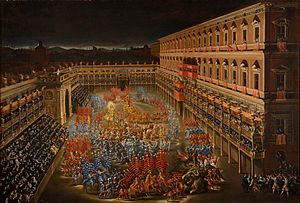Marco Marazzoli facts for kids
Marco Marazzoli (born around 1602 – died January 26, 1662) was an Italian priest and a well-known composer of Baroque music. He wrote many operas, oratorios, and other musical pieces, especially for the powerful Barberini family in Rome.
Contents
Early Life and Career
Marco Marazzoli was born in Parma, Italy. He trained to become a priest and was ordained around 1625. In 1626, he moved to Rome. There, he began working for Cardinal Antonio Barberini, a very important and wealthy leader.
Marazzoli often traveled with Cardinal Barberini. In 1631, he joined the cardinal on a trip to Urbino with other musicians. By 1637, Marazzoli became a special assistant to Barberini. He also started singing as a tenor in the Pope's chapel. In 1639, he officially became a "musico" (musician) for the Barberini family.
Composing for the Barberini Family
Marazzoli wrote many pieces for the Barberini family. In 1638, he composed music for a ballet called La piazza d'Orlando. The next year, he wrote music for a play called Chi soffre, speri. Both of these were performed at the grand Palazzo Barberini during Carnival celebrations.
After 1640, Marazzoli also started writing for other important people in cities like Ferrara and Venice. He created an opera, L'Amore trionfante dello Sdegno (also known as L'Armida), for a wedding in Ferrara in 1641.
Music During Conflict
In 1641, the Barberini family was involved in a conflict called the Wars of Castro. Marazzoli wrote music about a battle fought by Taddeo Barberini in a piece called Le pretensioni del Tebro e del Po. This was likely composed in late 1641. His opera L'Armida was also performed again in January 1642 to celebrate.
At Carnival in 1642, Marazzoli had another opera performed, Gli amori di Giasone e d'Isifile. After this, he went back to Ferrara. There, he directed another performance of Le pretensioni to celebrate Taddeo Barberini's return in March 1642.
Return to Rome and Paris
Marazzoli returned to Rome by mid-1642. He then composed the opera Il giudito della ragione tra la Beltà e l'Affetto (also called Il Capriccio). This opera was first performed at Carnival in 1643.
Towards the end of 1642, Marazzoli received special permission from the Pope to travel to Paris. He worked at the court of Anne of Austria, the Queen of France. He composed many chamber cantatas there, which the Queen greatly enjoyed.
Barberini Family in Exile
In April 1645, Marazzoli returned to Rome. He found that the Barberini family had been forced to leave Rome and go to France. They stayed in exile until 1653. During this time, Marazzoli focused on composing oratorios. Oratorios are like operas but without costumes or staging, usually based on religious stories. He wrote them in both Latin and Italian. Some of these were for a religious group called the Arciconfraternita del SS Crocifisso.
Barberini Family Returns
When Cardinal Antonio Barberini returned to Rome, he asked Marazzoli to compose an opera for the wedding of his nephew, Maffeo Barberini. Since there wasn't much time, Marazzoli worked with another composer, Antonio Maria Abbatini. Together, they created Dal male il bene, which was performed at Carnival in 1654 at the Barberini's theater.
Another opera, Le armi e gli amori, was planned for Carnival 1655. However, a new Pope was being chosen, which delayed the performance. It was finally performed in 1656. At the same time, Dal male il bene and Marazzoli's newest opera, Vita humana, were also performed. Vita humana was composed to honor Queen Christina of Sweden, who was visiting Rome.
Marazzoli might have also written the introduction for a ballet by Jean-Baptiste Lully in 1657 called L'Amour malade, but this is not certain. From 1655, Marazzoli composed works for Pope Alexander VII. The Pope even named him a special assistant in 1656. However, a plague hit Rome that year, and musical life slowed down until 1660.
Harpist and Death
Marazzoli was also a very famous harpist. He played a special gilded (gold-covered) three-rank "Barberini harp." This beautiful harp was even painted by the artist Giovanni Lanfranco. Today, it is kept at the Museo degli Strumenti Musicali in Rome.
Sadly, Marazzoli was seriously hurt in an accident during a church service at the Sistine Chapel on January 25, 1662. He died the very next day.
His Musical Works
Marco Marazzoli composed many different types of music during his life.
Operas
- La pazzia d'Orlando (1638, music is lost)
- La fiera di Farfa (1639)
- L'Amore trionfante dello Sdegno (L'Armida) (1641)
- Gli amori de Giasone e d'Isifile (1642, music is lost)
- Le pretensioni del Tebro e del Po (1642)
- Il giudito della ragione tra la Beltà e l'Affetto (Il Capriccio) (1643, music is lost)
- Dal male il bene (1654)
- La Vita humana (1656) - The story for this opera was written by Rospigliosi, who later became Pope Clement IX.
- Le armi e gli amori (1656)
Other Stage Works
- Intermedio for Troades (1640, possibly not by him)
- Prologue to Lully's L'Amour malade (1657, possibly not by him)
Oratorios
(All composed between 1645 and 1653)
- Latin Oratorios
- Erat fames in terra Canaan
- Erat quidam languens Lazarus
- Erat quidem languidus
- Homo erat pater familias
- Venit Jesus in civitatem Samarie
- O mestissime Jesu
- Italian Oratorios
- Per il giorno della resurrezione
- S Tomaso
- S Caterina
- Natale di N.S. (lost)
- Per ogni tempo (lost)
- S Giustina di Padova (lost)
- Ecco il gran rè de regi
- Poiché Maria dal sui virgineo seno
- Qual nume omnipotente che diè leggi
- Udito habbiam Giesù
Cantatas
Marazzoli wrote many cantatas. These are pieces for one to six voices, usually with musical accompaniment. A complete list of his cantatas can be found in Eleanor Caluori's article about him in The New Grove Dictionary of Music and Musicians.
See also
 In Spanish: Marco Marazzoli para niños
In Spanish: Marco Marazzoli para niños


